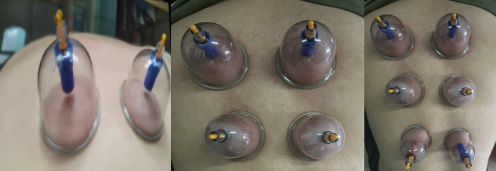
This study proposes a multi-view cupping spots image stitching method based on Canny SIFT to address issues such as limited field of view and unclear details of cupping spots during automatic cupping process. First, the image is preprocessed using bilateral filtering, and Canny edge detection is introduced to generate feature descriptors in combination with SIFT feature extraction algorithm. Then, RANSAC algorithm is utilized to screen and eliminate the mismatched feature points in order to obtain the optimal perspective transformation matrix. Finally, the weighted average fusion algorithm and morphological operations are combined to realize the multi-view cupping spots image splicing. Experimental results show that the algorithm proposed in this study improved the accuracy of feature matching for cupping spots images by 5% and 26% compared with the traditional SIFT and ORB algorithms, respectively. Moreover, the splicing speed also improved by 63%. The proposed method not only extracts more stable feature points, but also deals better with the problem of detailed features after fusion due to its improved splicing speed and quality.

To counter the ever increasing flood of image forgeries in the form of spliced images in social media and the web in general, we propose the novel image splicing localization CNN NoiseSeg. NoiseSeg fuses statistical and CNN-based splicing localization methods in separate branches to leverage the benefits of both. Unique splicing anomalies that can be identified by its coarse noise separation branch, fine-grained noise feature branch and error level analysis branch all get combined in a segmentation fusion head to predict a precise localization of the spliced regions. Experiments on the DSO-1, CASIAv2, DEFACTO, IMD2020 and WildWeb image splicing datasets show that NoiseSeg outperforms most other state-of-the-art methods significantly and even up to a margin of 46.8%.